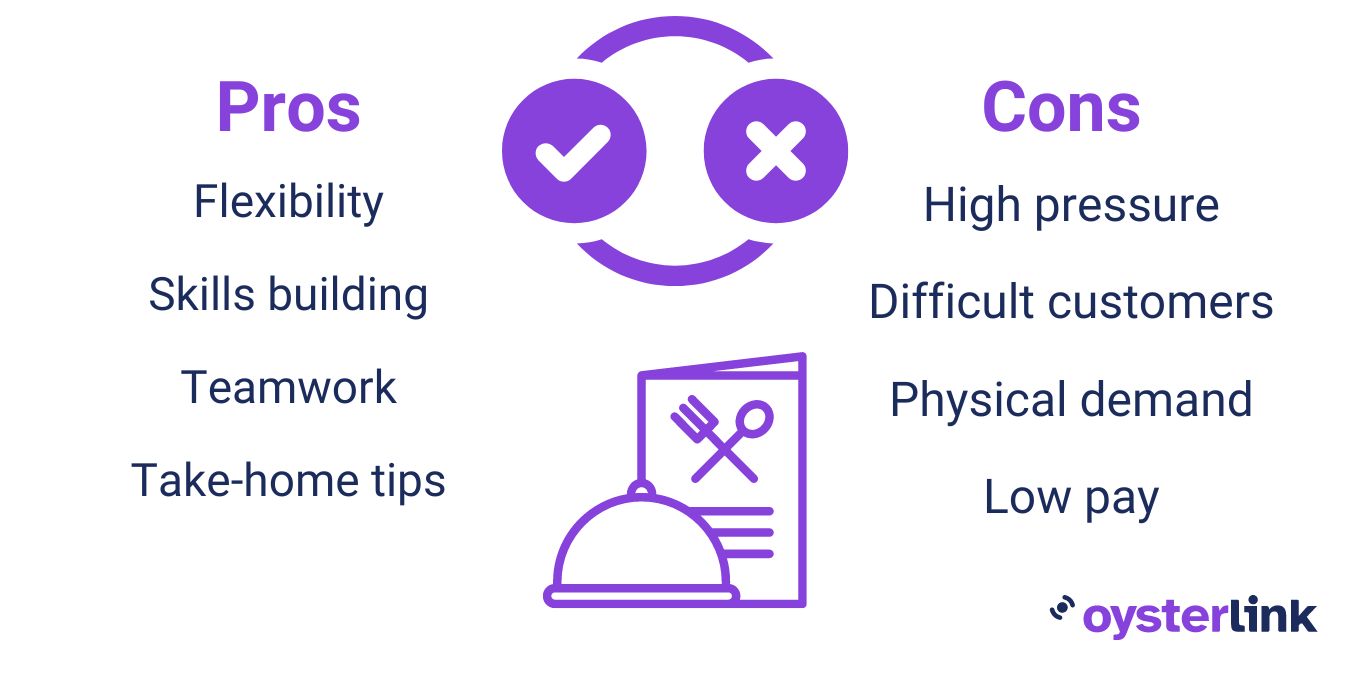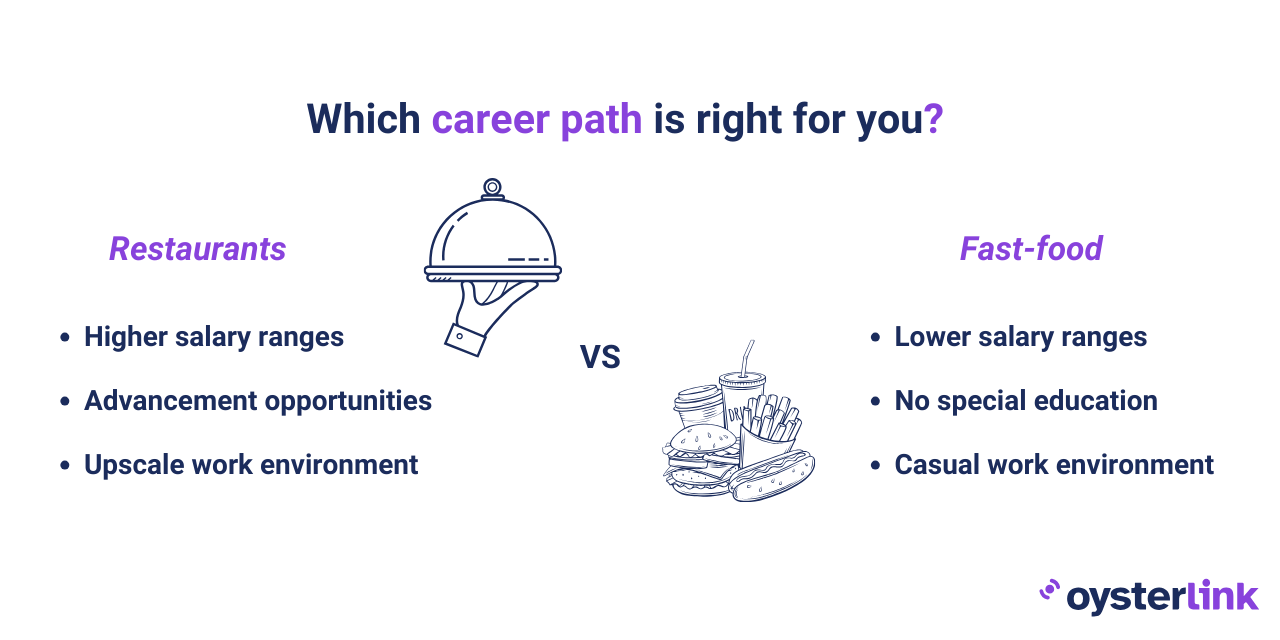Restaurants and fast-food chains are popular workplaces in the hospitality industry.
In fact, the food service industry is expected to grow by 200,000 jobs by 2024, reaching a total industry employment of 15.7 million.
[Source: National Restaurant Association]
Considering how 45% of operators are in need of more employees to meet the growing demand, is working in a restaurant a good career path?
In this article, we’ll share all you need to know about a career in the restaurant industry. Explore the 10 best-paying jobs and the skills you need in the restaurant industry.
We also explain the difference between restaurant and fast-food work, complete with entry-level fast-food jobs.
Plus, we’ll explain how you can land a job in a restaurant or fast-food chain with OysterLink.
Is Restaurant Work a Good Career Path?
If the fast-paced environment doesn’t make you sweat, then restaurant work can be a fulfilling and rewarding career.
With the many opportunities for growth, a Restaurant Server or Bartender can move up to a Restaurant Manager in a few years. A Barback can also move up as a Bartender and then eventually transition into a Sommelier, if the dedication is there.
Full-time restaurant employees can also enjoy many benefits that can include paid time off (PTO) and health insurance.
Keep in mind that salary ranges for restaurant positions can vary. While a Server can make $35,457 annually, not including tips, a Kitchen Manager’s salary can average $56,460 per year.
Pros and Cons of Restaurant Work
Although restaurant work can be an opportunity to make good money or build a career, it’s important to know what you’re getting yourself into.
Pros of Restaurant Work
Here are some of the most common reasons people love to take on restaurant jobs.
1. Flexibility
Restaurant jobs offer flexibility that’s hard to find in other industries. Whether you’re a student, a parent or someone with multiple jobs, restaurants can allow for varied schedules. You can then balance work with other commitments.
2. Skills building
Communication, time management and customer service are just some of the skills you can hone in restaurant work. You can use these not only in this industry but in many other fields.
3. Teamwork and camaraderie
The restaurant environment fosters a sense of teamwork and camaraderie among staff members. You’re all in it together in every shift to make sure you get the job done.
4. Take-home tips
One of the perks of working in a restaurant is the potential for take-home tips. While base wages may be modest, tips can significantly boost your earnings.

Cons of Restaurant Work
While restaurant work can be fulfilling, it also comes with challenges such as:
1. High-pressure environment
Working in a restaurant means you’re constantly multitasking and handling different tasks all at once. One minute, you’re taking orders, and the next, you’re managing reservations or directing customers to the bathroom.
2. Difficult customers
Dealing with difficult customers is an inevitable part of the job in restaurants. You have to keep your cool and handle their requests or complaints with professionalism, even when they’re being rude or unreasonable.
3. Physical demand
From standing for long periods to lifting heavy trays, restaurant work can get physically demanding. Also, the fast-paced environment may not always allow for proper breaks or adequate rest.
4. Low pay
Despite how demanding restaurant work can get, wages for entry-level positions are often minimal. Tips are often the saving grace to increase take-home pay.
Why Give Restaurant Work a Shot
Now that you know the pros and cons of restaurant work, it’s time to weigh up what you stand to gain. Check out the average salary ranges for restaurant positions.
Top 5 Skills You Need for Restaurant Work
Any work requires a set of skills for you to succeed and get the job done. Here are the best skills you need to have or can develop as you work in the restaurant industry.
1. Customer Service
Restaurant work demands providing efficient, friendly service to ensure guest satisfaction. You need to promptly address customers’ needs and make them feel taken care of.
2. Communication
Clear communication with customers, coworkers and management is vital in restaurants. When the kitchen receives accurate orders, and the front-of-house staff knows when they’ll be ready, customers are happy.
3. Time Management
Efficiently prioritizing tasks and adhering to schedules is crucial. With time management, you know your tasks and how to prioritize. Also, timely service means customers don’t have to wait that long, and who doesn’t want that?
4. Adaptability
Restaurants often face dynamic environments with unpredictable challenges. Adaptable employees quickly respond to changing circumstances, while ensuring seamless operations.
5. Attention to Detail
One wrong order noted down can lead to a disaster in the kitchen. From plating dishes to making sure reservation schedules don’t overlap, attention to detail is key.

10 Best-Paying Jobs in a Restaurant
From managerial positions to culinary roles, here are the 10 best-paying jobs in the restaurant industry. These will likely require special training, certificates and education.
1. Wine Steward or Sommelier
A Wine Steward, also known as a Sommelier, supervises the wine list at a restaurant, bar or hotel.
Other responsibilities of a wine steward include creating and updating the wine list, and curating wines. They can also train staff on wine service and pairing.
- Average salary: $65,581
- Benefits: Non-cash benefits such as health insurance and PTO
- Opportunities for growth: Wine Director or Wine Manager
- Experience: Knowledge about extensive wine lists and wine service procedures is required.
- Education: A General Education Development (GED) certificate or high school diploma is required. An associate’s or bachelor’s degree in hospitality is a plus.
- Certification required: L3 wine certification from a reputable wine school
2. Director of Restaurant Operations
A Director of Restaurant Operations oversees all aspects of the company’s daily operations. This includes creating operational strategies to reduce costs and enhance efficiency. They also collaborate closely with executives to achieve objectives.
- Average salary: $102,697
- Benefits: Non-cash benefits such as health insurance and PTO
- Opportunities for growth: General Manager or Executive Chef
- Experience: Prior experience in catering and hospitality, as well as customer service and communication skills, is required.
- Education: An associate’s or bachelor’s degree in hotel and restaurant management is required.
3. Executive Chef
An Executive Chef creates menus, orders supplies and manages inventory. They supervise and train kitchen staff, ensuring that food is prepared to the highest standards.
- Average salary: $80,040
- Benefits: Non-cash benefits such as health insurance and PTO
- Opportunities for growth: Private Chef, Director of Restaurant Operations or Culinary Instructor
- Experience: More than five years of being a head chef is required.
- Education: An associate’s or bachelor’s degree in culinary arts is required.
4. Restaurant Manager
A Restaurant Manager’s role includes supervising staff to oversee food preparation and service.
This includes hiring and training staff, and managing the restaurant’s budget. They also ensure compliance with health, safety and sanitation regulations.
- Average salary: $61,310
- Benefits: Non-cash benefits such as health insurance and PTO
- Opportunities for growth: Regional Manager or Restaurant Owner
- Experience: Relevant experience and customer service skills are required.
- Education: A high school diploma is required. A bachelor’s degree in hospitality or training is a plus.
5. Bartender
A Bartender prepares and serves both alcoholic and non-alcoholic drinks to customers responsibly. They also upsell other menu items — such as appetizers or desserts.
On top of creating drinks, a Bartender maintains a clean and organized bar area.
- Average salary: $34,490
- Benefits: Non-cash benefits, such as health insurance and PTO, for full-time employees
- Opportunities for growth: Bar Manager or Front of House Manager
- Experience: Knowledge in preparing and serving both non-alcoholic and alcoholic drinks is required.
- Education: A high school diploma and bartending courses at a community college are a plus.
6. Line Cook
A Line Cook prepares ingredients for dishes. This includes chopping vegetables, cutting up meat and preparing sauces and soups.
In addition, a Line Cook is responsible for following recipes and presentation guidelines to prepare dishes. They monitor food inventory and restock as needed. They also manage the stove and other cooking equipment.
In some cases, a Line Cook is also in charge of managing a dedicated station in the kitchen — such as the grill or sauté station.
- Average salary: $33,829
- Benefits: Non-cash benefits such as health insurance and PTO
- Opportunities for growth: Bar Manager or Front of House Manager
- Experience: Prior experience in cooking and food preparation.
- Education: A culinary school certificate or high school diploma is required. If you work in Florida or Illinois, you’ll also need a handler safety certificate.
7. Pastry Chef
A Pastry Chef plans and creates menus for desserts and baked goods. They also order supplies, manage inventory and train other Pastry Chefs and Bakers.
They can also create decorative pieces for desserts, such as chocolate sculptures or edible sugar flowers.
- Average salary: $54,995
- Benefits: Non-cash benefits such as health insurance and PTO
- Opportunities for growth: Executive Pastry Chef or Consulting Pastry Chef
- Experience: Two or more years’ worth of experience working within the food industry as a Baker is required.
- Education: A high school diploma is required, while a certificate in culinary arts, pastry-making or baking is a plus.
8. Sous Chef
A Sous Chef is the second in command in a kitchen under the Executive Chef. The Sous Chef is in charge of helping the Executive Chef with menu planning and food preparation.
If the Executive Chef is absent, the Sous Chef steps in to fulfill the Executive Chef’s responsibilities.
- Average salary: $56,013
- Benefits: Non-cash benefits such as health insurance and PTO
- Opportunities for growth: Executive Chef
- Experience: A cooking apprenticeship in any hotel or restaurant for three years or more is required. You would also need around three years of professional experience before eligibility.
- Education: A high school diploma or GED certificate is required.
9. Kitchen Manager
From ordering supplies and managing inventory to monitoring food costs and controlling expenses, a kitchen manager is responsible for overseeing the overall operation of a restaurant kitchen.
- Average salary: $56,640
- Benefits: Non-cash benefits such as health insurance, PTO and a flexible schedule
- Opportunities for growth: Restaurant Manager or Front of House Manager
- Experience: More than three years of Kitchen Manager or leadership experience is required. Depending on the state, a food handler’s card is also required.
- Education: A high school diploma or GED certificate is required.
10. Barista
A Barista prepares and serves coffee using a variety of brewing methods. This includes knowing the ins and outs of espresso machines, drip coffee makers and French presses.
They provide recommendations to customers and upsell other menu items. A Barista is also responsible for maintaining equipment and preparing food, such as pastries and sandwiches.
- Average salary: $37,839
- Benefits: Non-cash benefits such as health insurance and PTO
- Opportunities for growth: Shift Manager
- Experience: Prior experience in customer service and food and beverage preparation is preferred.
- Education: A high school diploma is required.
Restaurants vs. Fast-Food Chains: What’s a Better Career Path?
Here are key factors to consider when determining which type of establishment is a better restaurant career path for you:
- Education requirements: Most restaurant jobs require employees to have at least a high school diploma. On the other hand, most jobs in the fast-food industry don’t require special education or extensive experience.
- Work environment: Restaurants typically offer a more upscale work environment than fast-food chains.
- Opportunities for growth: Both types of establishments offer opportunities for advancement.
- Salary: Pay in the food industry can vary. Restaurants generally offer higher salary ranges — especially for jobs requiring specialized training.
6 Best Entry-Level Jobs in a Fast-Food Chain
With more than 5 million fast-food employees in the United States in 2023, starting out in fast food can help you build the experience you need to jumpstart your career in hospitality.
Here are the six best entry-level jobs in the fast-food chain industry that don’t require special education or extensive experience.
Keep reading: Fast-Food Worker Interview Questions
1. Shift Manager
A shift manager, also referred to as a shift lead, oversees the operations of the fast-food chain, including supervising staff, handling customer complaints and inquiries and ensuring that the restaurant is clean and well-maintained.
Typically, a shift manager reports to the restaurant manager or assistant manager, and they may have the authority to make decisions and solve problems within their shift.
- Average salary: $36,000
- Benefits: Non-cash benefits such as free meals, an employee assistance program, tuition assistance and paid time off
- Opportunities for growth: Restaurant Manager or Assistant Manager
- Experience: Previous experience in a managerial role is required.
- Education: A high school diploma or a GED certificate is required. Some employers prefer a Bachelor’s Degree in Management, Hospitality or Business Administration.
2. Fast-Food Cook
A fast-food cook prepares takeaway food such as pizzas or burgers, operates cooking equipment such as griddles, ovens and deep fryers, and manages sanitation, health and safety standards in their work areas.
- Average salary: $34,000
- Benefits: Non-cash benefits such as free meals, an employee assistance program, tuition assistance and paid time off
- Opportunities for growth: Line Cook or Assistant Manager
- Experience: Prior experience in the industry and basic cooking knowledge are required.
- Education: A high school diploma or a GED certificate is required.
3. Pizza Delivery Driver
A pizza delivery driver distributes pizzas and other food items to customers’ homes or businesses, collects payment for the order and ensures that the correct order is delivered to the customer on time.
Typically, pizza delivery drivers use their own vehicles to make deliveries and are required to use a GPS or other navigation device to find their way to each destination.
- Average salary: $34,000
- Benefits: Non-cash benefits such as free meals, an employee assistance program, tuition assistance and paid time off for full-time employees
- Experience: Does not require any work experience.
- Education: No education is required, but you must be at least 18 years old.
4. Busser
A busser, also known as a food runner, cleans and sets tables, restocks supplies, refills water glasses and provides other beverages as needed.
When needed, a busser may also be responsible for performing cleaning tasks in the dining room, such as sweeping and mopping.
- Average salary: $32,000
- Benefits: Non-cash benefits such as free meals, an employee assistance program, tuition assistance and paid time off for full-time employees
- Opportunities for growth: Server
- Experience: Does not require any work experience.
- Education: A high school diploma or a GED certificate is required.
5. Maintenance Personnel
Maintenance personnel in a fast-food chain keeps the restaurant clean and organized by sweeping and mopping floors, and cleaning the dining area, restrooms and kitchen. This position is also in charge of taking out the trash and ensuring that all equipment is in good working order.
In addition to cleaning duties, maintenance personnel make sure that leaky faucets are repaired and dim light bulbs are replaced.
- Average salary: $32,000
- Benefits: Non-cash benefits such as free meals, an employee assistance program, tuition assistance and paid time off for full-time employees
- Experience: Proven maintenance experience and knowledge about power tools are required.
- Education: A high school diploma or a GED certificate is required.
6. Cashier
A cashier collects payments from customers, operates credit card authorization systems and balances cash drawers by counting cash at the start and end of the work shift.
- Average salary: $31,000
- Benefits: Non-cash benefits such as free meals, an employee assistance program, tuition assistance and paid time off for full-time employees
- Opportunities for growth: Shift Manager
- Experience: This does not require any work experience. However, some employers might prefer at least one year of experience in a customer service position.
- Education: A high school diploma is required.
Restaurants vs. Fast-Food Chains: What’s a Better Career Path?
Here are key factors to consider when determining which type of establishment is a better restaurant career path for you:
- Education requirements: Most restaurant jobs require employees to have at least a high school diploma with special training. On the other hand, most jobs in the fast-food industry don’t require further education or extensive experience.
- Work environment: Restaurants typically offer a more upscale and formal work environment, while fast-food chains are more casual.
- Opportunities for growth: Both types of establishments offer opportunities for advancement.
- Salary: Pay in the food industry can vary. However, in general, restaurants offer higher salary ranges—especially for positions that require specialized training or education.

The best career path for you depends on your interests, skills, experience and goals.
6 Best Entry-Level Fast-Food Jobs
If you’re just starting, you can go up the ladder step by step. With around 5 million fast-food employees in the United States, starting in fast food can give you the experience and skills you need.
Here are the six best entry-level jobs in the fast-food industry.
1. Shift Manager
A Shift Manager, also referred to as a Shift Lead, oversees the operations of the fast-food chain. They supervise staff and handle customer inquiries while ensuring the restaurant’s maintenance.
A Shift Manager reports to the Restaurant Manager or Assistant Restaurant Manager. They can also have the authority to make decisions and solve site issues.
- Average salary: $36,000
- Benefits: Non-cash benefits such as free meals, employee and tuition assistance and PTO
- Opportunities for growth: Restaurant Manager or Assistant Manager
- Experience: Previous experience in a managerial role is required.
- Education: A high school diploma or a GED certificate is required. Some employers prefer a bachelor’s degree in Management, Hospitality or Business Administration.
2. Fast-Food Cook
A Fast-Food Cook prepares takeaway food such as pizzas or burgers. They operate cooking equipment and manage sanitation, health and safety standards.
- Average salary: $30,000
- Benefits: Non-cash benefits such as free meals, employee and tuition assistance and PTO
- Opportunities for growth: Line Cook or Assistant Manager
- Experience: Prior experience in the industry and basic cooking knowledge are required.
- Education: A high school diploma or a GED certificate is required.
3. Pizza Delivery Driver
A Pizza Delivery Driver distributes pizzas and other food items to customers’ homes or businesses. They collect payments for orders and ensure accurate and on-time delivery.
Typically, Pizza Delivery Drivers use their vehicles to make deliveries. They are required to use a GPS or other navigation devices.
- Average salary: $32,000
- Benefits: Non-cash benefits such as free meals, employee assistance and PTO for full-time employees
- Experience: No previous work experience is required.
- Education: No education is required, but you must be at least 18 years old.
4. Busser
A Busser cleans and sets tables, restocks supplies, refills water glasses and provides other beverages as needed.
When needed, a Busser may also be responsible for performing cleaning tasks in the dining room, such as sweeping and mopping.
- Average salary: $30,040
- Benefits: Non-cash benefits such as free meals, employee assistance and PTO for full-time employees
- Opportunities for growth: Server
- Experience: No previous work experience is required.
- Education: A high school diploma or a GED certificate is required.
5. Maintenance Personnel
Maintenance Personnel keep the restaurant, including the dining area, restrooms and kitchen, clean. They are also in charge of taking out the trash and ensuring that all equipment is in good working order.
They also make sure that leaky faucets are repaired and dim light bulbs are replaced.
- Average salary: $32,000
- Benefits: Non-cash benefits such as free meals, employee assistance and PTO for full-time employees
- Experience: Proven maintenance experience and knowledge about power tools are required.
- Education: A high school diploma or a GED certificate is required.
6. Cashier
A Cashier collects payments from customers and oversees the card authorization process. They also balance cash drawers and make sure this is done at the start and end of every work shift.
- Average salary: $28,730
- Benefits: Non-cash benefits such as free meals, employee assistance and PTO for full-time employees
- Opportunities for growth: Shift Manager
- Experience: This does not require any work experience. However, some employers prefer at least one year of experience in a customer service position.
Education: A high school diploma is required.
How Do You Get Started With a Restaurant Career?
If you’re interested in starting a career in the restaurant industry, here are some steps you can take:
- Explore your options: The restaurant has different positions and responsibilities to choose from. Consider what type of restaurant you would like to work in. For example, fine dining or a coffee shop. Then, decide on the position you would like to apply for. For example, Restaurant Manager or Line Cook.
- Pursue education and training: A hospitality degree/certification can aid your career advancement.
- Build your network: Building relationships with professionals can help you explore job opportunities. Consider joining an organization such as the National Restaurant Association. You can also participate in industry events. Through these, you can meet potential colleagues, employers, mentors and employees.
- Find job openings and apply: Once you have experience and a clear goal, start looking for a job that matches your goals. Be prepared to start at entry-level positions and work your way up as you gain experience and skills.
Find High-Paying Restaurant Jobs With OysterLink
Whether you’re looking for career growth or starting in the hospitality industry, build and grow your network with OysterLink.
With OysterLink, you can look for open job positions in restaurants and fast-food chains.

